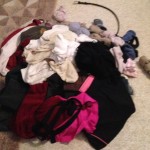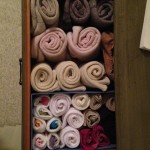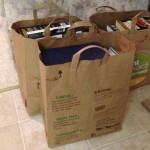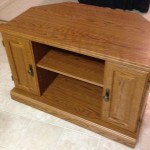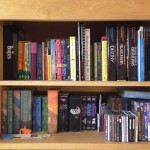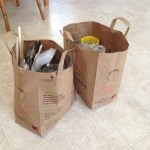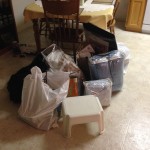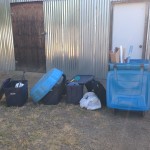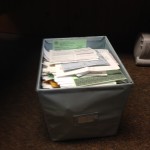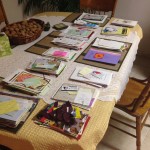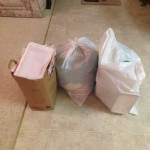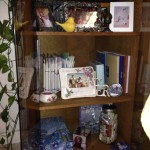If there is one word people consistently use to describe me it’s “organized.” So when my lovely sister Carolyn mentioned a library book with a 300+ person waiting list called The Life-Changing Magic of Tidying Up: The Japanese Art of Decluttering and Organizing by Marie Kondo, I was intrigued. I wondered what would make a book on “tidying” so popular, and also whether there was anything more I could learn on the subject. Turns out, the answer to the second question was a lot. Organized is not the same as tidy. In many ways I was just as much a hoarder as the next American influenced, however indirectly and going back multiple generations, by the Great Depression. The only difference between me and the hoarders who get on TV shows was my gratuitous belongings were sorted, labeled, and stuffed somewhat neatly and out of sight in a drawer, box, shed, attic or closet. This post outlines my journey to a more clutter-free life.
To paraphrase an idea gleaned from an interview with Tom Chi (Google): If you decide to form a new habit, rather than just using limited willpower to battle the deeply entrenched neurons relating to your old habit; help the new habit along by finding a way to also move time, space, or matter to support it. Marie’s tidying method, the KonMari method, is a perfect way to move matter in a way that supports a new habit of thought.
So what new habits of thought could truly tidying your space support? Well, how about thoughts of love, joy, purpose, abundance, authenticity, inner peace, intuition, courage, generosity and clarity to name a few. The only other technique I know of to improve these things is meditation.
I titled this post The Art of Discarding because that’s how I would rename Marie’s book to target a more empirical American audience. Many of us would like to have less clutter, but don’t know where to start. The mere idea can throw us into paralyzing overwhelm. The KonMari method is simple, inspiring, step by step, and deals with not only the physical sources of clutter, but the mental and emotional as well. The mental/emotional aspect is what makes de-cluttering more of an art. It may seem like a lot of work initially, but the payoff is once you dig in and get it done, you will never regress to clutter and chaos again. It is a one-time only project and well worth the effort, because many of her students also find the lessons carry over into other areas of their life as well. I found that once I got some momentum going, it was also, dare I say it, sort of fun.
The system can be distilled into two basic steps. Tackle one category of belongings at a time, and physically touch and consider (i.e., be present with) each item as you work through a given category and ask yourself the question; “Does it bring me joy?” The categories move from easiest to hardest to build both momentum and allow practice with the method. The tidying project is intended to be completed all at once, but as I never have a full day home to myself I compromised by moving though at least one category every night until it was complete. The point is to just get it done once and for all and not procrastinate and painfully drag it on.
Other de-cluttering advice I had previously followed was to look around a room and ask if I loved the stuff in it. If yes keep it, if no let it go. This fell short of the KonMari method for two reasons. First, this didn’t require that I physically pull out and touch all items of a given category, even if that category was Room A, so clutter got missed. Either because it stayed hidden and forgotten in a closet, or because it just blended in as part the room and was overlooked. Second, though there were things that I didn’t love, I knew I had to keep them for some other utilitarian reason. I needed a better question.
Day 1: Clothes
Clothes are the first and easiest category because most of us are used to replacing them on a fairly regular basis so there’s not a lot of emotional turmoil and uncertainty in discarding. I dutifully collected every article of clothing I owned from closets, drawers, laundry etc., until I had a somewhat daunting mountain on the bed. I first picked up a pair of socks and immediately knew why the best question had to be, “Does it bring me joy?”
If I had asked, “Do I love the socks?” the answer would have been “No, they’re just socks.” There’s still uncertainty as to whether or not to keep them. However, when I asked, “Do they bring me joy?” the answer in this case was a resounding “YES!” This particular pair was one of my favorite pairs of wool hiking socks to take on adventures. The keep pile had begun.
I moved through my mountain rather quickly and easily, and when it was finished I surveyed the massive discard pile. This is where the connection begins to build with positive habits of thought. It takes intuition to discern the yes or no response. In a nutshell, yes is light and expansive, no is heavy, constricting, or even wishy-washy. It takes authenticity to be willing to listen to the yes or no and not dismiss it because of what someone else might think. It takes courage to face past mistakes in clothing purchases, and generosity to donate them where they may do the most good.
On looking at the keep pile, I could see more clarity and purpose in my life choices physically represented in the clothes that brought me joy, both in terms of career direction as well as leisure. I could see where the gaps were in how I needed to better care for myself and my own needs where joyful clothes in that area were sparse or worn out.
Once I put only things that brought joy back in the closet, the energy that came back when I opened the door was (and still is) fantastic. Actually, now I usually just leave the door open. I had a brief experience working in big box clothing retail store and shudder at the memory of the go-back rack in the busy fitting room. It’s so lovely not to have that nightmare staring back at me from my own closet, and to instead look at something that more resembles a high end clothing boutique.
Another bonus is it is now super easy now to pack for my frequent travel. The bags of discarded clothes (and extra hangers) to donate was like a huge weight being lifted out of my life. This energy built a ton of momentum to push me happily into the next category. I looked forward to Day 2.
Day 2: Books
Don’t forget the cookbooks stashed in the kitchen when collecting and consolidating this category. The book category is where people often uncover their life purpose once they survey the books that remain. I did not have any revelations in this area, but was able to merrily discard a piece of furniture that never fit well in my current house, but I had been keeping anyway as a place to store books. I also combined this category with CDs and DVDs since most of my collection had long since been sold as technology shifted to streaming and was already sparse. Besides being a few grocery bags full of books lighter, my reward was a more open living room without unwanted and now unnecessary furniture. Embrace the Kindle app and additional momentum and bring on Day 3.
Day 3: Kitchen
The next category in the book is technically paper, but as it was personally my second hardest category, I saved it for second to last in following the spirit of the process.
I had previously de-cluttered my kitchen by banning all unnecessary plastic. I was on a mission at the time to be more healthy and more authentic and to me plastic was neither of those things. So out went a trunk load of cups, mixing bowls, cheap storage containers, utensils, etc. to be donated. I replaced anything that was necessary with glass and bamboo items, just as inexpensive but so much more attractive, by shopping at places like Ross, and slowly building up a collection of glass Pyrex storage containers as they went on sale.
Even so, by using the KonMari method and actually touching every kitchen item I owned, I was able to discard two more bags and also rediscovered items that brought me joy, in the form of delicious meals, that had been hiding in a kitchen cabinet.
Day 4: Komono (Doodads)
My other lovely sister Cindy and I got a good laugh when I told her I culled a mountain of towels and blankets out of my hall closet. She remembered, but I had forgotten that I was repeating our mother’s pattern of keeping so many old blankets that it was nearly impossible to pry one in and out of the closet. Our childhood blanket closet, once the blankets were pried out, was big enough for a 7 year old kid to stand in and pretend they were on a rocket to the moon.
How many blankets does one really need? Best donate the rest so one of your human brothers or sisters might be able to keep themselves, a child, or a pet, warm. As a bonus, this year once the weather turned cold, it was a pleasure, whereas it used to be a total pain, to locate and remove the blankets I actually use from the closet.
Tip: Do not sort and discard art/office supplies by dumping your collection on your newly shampooed carpet or you will be sorry.
The other stash of household items worth mentioning is cleaning supplies, paint, and household chemicals. These tend to hide under the sink or in a garage because if you don’t end up using them and are also conscious of the effects on the environment so won’t throw them away (thank you), they pile up. I hunted these items down, found paint I had been carrying with me for 19 years, and took a box to the local hazmat station.
Day 5: Papers
Discard all papers.
Wait, what?
The rule was simple enough to understand, but the mere suggestion cued the proverbial screeching record in my head. I make my living as an accountant which means I have “historian” as part of my personality. Papers were definitely my biggest hoard and I was as apprehensive at getting rid of them as the lawyers in Marie’s book.
You want the warranty and manual to every device I’ve ever owned? Check. Paystubs from every job I’ve ever had? Check. Bank and credit card statements going back 7 years? Check. Every rock chart and field show I ever played in college? Check. Every school newspaper from high school? Check. File folder overflowing with recipes? Check. Every greeting card I’ve ever received in my life, even if from my childhood orthodontist? Check. Every note I’d ever been passed in Jr. High, still in its fancy fold? Check. Report cards? Check. Receipts from 20 years ago? Check. The list went on.
My first impulse was to rebel against the advice in this category, but as I had momentum built already, I remembered again that I work as an accountant. In a 21st century office. At work my authentic self actually loathes and despises all paper. I’m able to get away with this attitude because we have access to top-of-the line scanning equipment and PDF software and I am a “paperless office” champion where I work. Why not bring this authentic self home with me as well? I really do hate paper!!!! It’s heavy, slow, messy, and vulnerable to fire. What I am attached to is the information on it.
So I’m modifying this rule to say, do everything you can to go paperless. Understandably not everyone has easy access to fast scanners and expensive PDF software, but do what you can. Most people don’t have an aversion to simply tossing old pay stubs like I do, but we all should keep things like tax returns. Scan them if possible.
I’d love to say that this category took one night, but as it was my biggest hoard, it took days, even weeks, because I kept stumbling across new hiding places. I would bring a mountain of paper to the office and scan for hours after hours, sometimes staying in until midnight.
- Financial Records. Most of these were scanned and then shredded. Items to consider:
- Tax returns and support (W-2s, 1099s, etc). These should be kept forever in the US, but there’s no rule they can’t be scanned. Make sure to keep a backup.
- Bank and credit card statements. These should be kept for 7 years. Old paper statements were scanned, most of my current statements are set up to be “paperless” anyway and I just save them directly from the bank.
- Pay stubs. No need to keep more than a year, I scanned and kept all of them just for historical interest.
- Receipts. Unless they were related to something medical, those 20 year old receipts were discarded. I do have a small accordion file to keep recent receipts for items that might need to be returned, but this is purged regularly.
- Insurance policies and estate plan. This is currently my one exception, besides temporary recent receipts, to my paperless policy. I have a 3 ring “legacy binder” based on an excellent article from Dave Ramsey for my next of kin in case the inevitable happens sooner than expected. I keep it in paper form so it’s easy for someone else to find and use if needed. This may eventually change as more people in my life embrace the cloud.
- School stuff and articles. I kept a few sentimental items in books, but most of this category was scanned and shredded. Bonus, I was able to easily share the high school newspapers on my class reunion Facebook page via DropBox. Being able to share them someday was most likely my youthful motivation for keeping them in the first place. Win.
- Warranties and manuals. These were just trashed. Yay internet, all that sort of info can be found online these days.
- Recipes. I input all these into an app called Pepperplate, but there are other apps to consider. The fantastic thing about this being done is now my recipes are with me wherever I go, most effectively, at the grocery store. They’re also tons easier to instantly share.
- School notes. Most of these were trashed since I could barely read/remember who they were from. However I put the ones from my childhood BFF into a book that will someday go to her kids.
-
Greeting Cards. The longest part of this subcategory was collecting and consolidating the cards from their various storage locations. Once I finally had them all on the table, I sorted them by giver, and then discarded ones from people I will likely never interact with again (i.e., the childhood orthodontist). The others I hole-punched and made into little books using binder rings, to be returned to the giver or child/grandchild of the giver someday. For now, since they bring me joy, they live on the shelf next to photo albums to be flipped through at leisure.
- Ticket stubs. I had various collections of these from every movie, concert, event, etc. I’ve ever gone to, dating at least as far back as high school. I discarded large items like old playbills, but took an idea from Pinterest and put all of my ticket stubs into a large mason jar that now lives with the photo albums. It brinks me joy to see and think of all those life experiences and makes a great conversation piece.
Boom! Not overnight, but what a relief to have the mountains of annoying, stressful paper gone, and the information easily accessible and appropriately backed up on a computer.
Day 6: Sentimental Items
This is the category all the other categories build up to, because it can take some serious chutzpah to discard it. Since the sentimental items were so closely tied with paper I worked on them somewhat concurrently. The hardest part was locating and consolidating all of my various boxes of sentimental items collected over the years. I had heavy trunks full of doodads from primary school and college, as well as accordion files and boxes of items I had saved, stored, and moved without much thought since then. It was a total pain getting a lot of this type of boxes out of the attic (no boxes will ever return there). Once all the boxes, trunks, and suitcases were in a pile on the living room floor, I summoned the courage to open them and face the past.
Other than a few emotional land mines, such as remnant photos involving unpleasant old relationships that had somehow survived the previous bonfires, or having to read notes betraying painful evidence of those immature teenage years, most of it was fun. One box full of elementary school treasures brought those carefree days back. The sea of greeting cards to be sorted reminded me that I am loved and have been blessed with many friends over the years.
Like Marie’s clients, I too was guilty of hoarding photo envelopes with every blurry photo ever printed (thank goodness for digital) and all their negatives. Most of these were trashed since the good photos were already in albums and/or scanned. I did keep a few loose ones that still brought joy in a pretty box with the other albums, at least until they can be scanned.
I boxed up old VHS tapes and audio cassettes and sent them to a service to be digitized before discarding. A few items such as yearbooks, a binder ring of student IDs and old driver licenses, and the old letterman jacket I still wear to homecoming went back in the trunk, just not in the attic. Most sentimental items I kept were worked in to my current life. What’s the point of keeping things that bring joy if I never see them?
Two interesting things happened once the de-cluttering was done. First, people often ask Marie whether they regret discarding anything. The answer she gave was rarely, and if it happens, it is hardly catastrophic and usually something easily laughed off. My one regret is no exception. While I was throwing away most of my household “spare hardware” collection, I picked up and considered a box of old light bulbs. Figuring if a light bulb ever went out again I would replace it instead with an LED, I chucked them. The second, and I am not exaggerating, the second I walked back in the house from taking those bulbs along with a trunk load of other stuff to the donation center, I flipped on a light and *plink* it went out. Really, universe?? I knew I said I would replace it with an LED, but I would have kept at least one old bulb if it meant saving me a trip back into town to buy a new one so soon.
The other interesting thing was, I had kept some pairs of work pants I wore to work all the time but didn’t particularly like, more because it was being able to keep my job that brought me joy than the pants. Mere weeks later we received an email from the boss that they had relaxed the archaic dress code and jeans would be allowed on all regular work days where important meetings weren’t involved. Apparently they had received the etheric download. The ugly work pants were donated not long after. Win.
Epilogue: Time Clutter
This category is not part of the KonMari method, but I used the momentum from successfully de-cluttering and simplifying my stuff to tackle my most challenging category of all: time clutter. Time, or lack thereof, has been a challenge for me since I began my career as a CPA. It mostly takes the form of unfinished projects; many abandoned at the start of tax season and procrastinated for as long as four years. Over the course of just one month, I managed to complete them ALL, and then some. This has done amazing things to lower stress, increase inner peace, improve my energy levels, gain more clarity as to my life purpose, and improve my intuition. I’ve become more effective at work by “clearing the clutter” and getting right down to what it will take to simply get a project done. I feel like I have more time, or at least less guilt, to begin NEW projects and move forward with my life in a more authentic fashion.
Do you own your stuff or does your stuff own you? Whether you choose to be aware of it or not, your energy supports your stuff. Does it support you back? Do you love yourself enough to surround yourself only with things that bring you joy? Do you trust in the abundance of the universe enough to let go of the things that don’t? Are you willing to practice generosity by donating? Are you willing to be aware and clear about what brings you joy (and what doesn’t)? Are you willing to be clear and purposeful as to what you choose to create and surround yourself with? Are you willing to deal with it NOW instead of potentially leaving an unpleasant legacy to your next of kin?
Marie addresses many other issues that I didn’t touch on here, such as what to do if you don’t live alone and your mate is a hoarder, how to address emotional objections to discarding things like gifts, and how to properly organize and put away what’s left after discarding so your stuff never gets chaotic again. It’s a very worthwhile book and I hope it helps you as much as it helped me.

